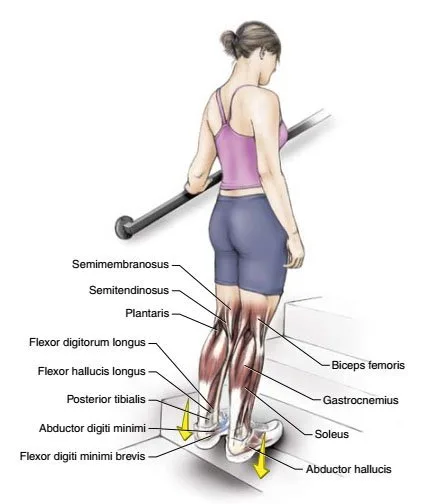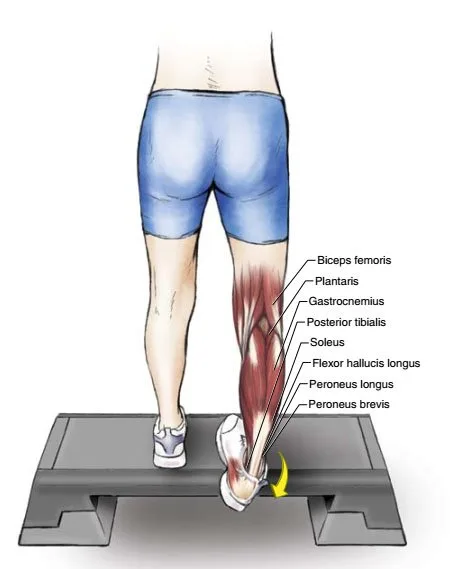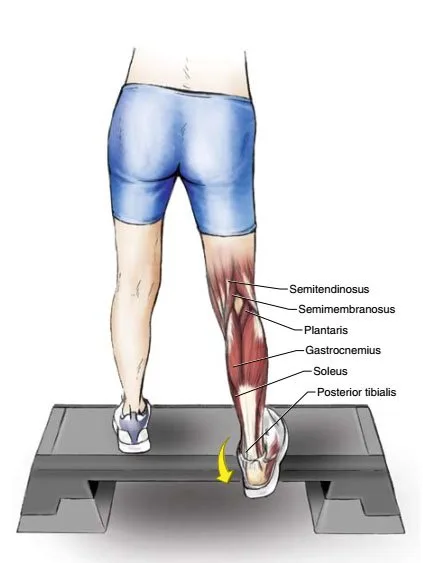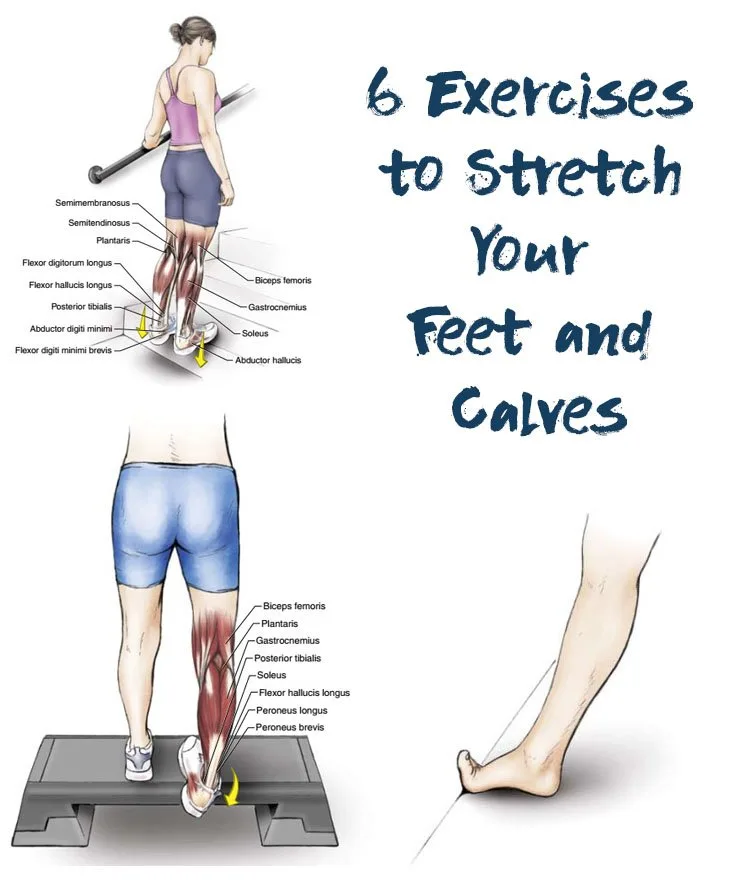In normal everyday activities, the muscles of the foot and lower leg are used more extensively than any other muscles in the body. Even though the musculature of the lower leg is considerably smaller than that of the upper leg, it essentially supports the whole body and receives the heaviest load during both walking and standing. Consequently, many people have minor aches and pains in these muscles at the end of the day. Soreness, tightness, cramping, restlessness, and weakness in the arch of the foot and calf muscles are just some of the common complaints. Stretching and strengthening these smaller muscle groups can alleviate most of the daily fatigue and pain. Stretching can also improve flexibility and stamina. Practicing our toe, ankle, soleus and gastrocnemius stretches will bring improvements that will enable this muscle groups to work harder and longer throughout the day, without consequences.
Please note that the instructions are given for the right side of the body. Similar but opposite movements should be used for the left side of the body.
Toe Extensor Stretch

Instruction
Stand upright and brace against a wall for balance, pointing the right foot backward away from the body. The top side of the toes is placed down against the floor.
While keeping the toes pressed against the floor, lean your weight onto the right leg and press the bottom of the heel down toward the floor.
Primary Muscles Stretched: Right extensor digitorum brevis, right extensor hallucis brevis, right anterior tibialis, right peroneus tertius.
Commentary
Comfort-wise, it’s better to perform this stretch on a carpet or other soft surface. Be careful not to drag the foot pressed to the floor. If you move the heel medially or laterally, you can place greater stretch on the dorsal medial/lateral parts of the foot.
Toe Flexor Stretch

Instruction
Stand upright and facing the wall, approximately 1 to 2 feet away. While keeping the heel of the foot on the floor, press the bottoms of your toes of the right foot up against the wall. The ball of the foot should be more than half an inch above the floor. Lean forward and slide the ball of the foot slowly down, keeping the toes pressed against the wall.
Primary Muscles Stretched: Right flexor digitorum brevis, right quadratus plantae, right flexor digiti minimi brevis, right flexor hallucis brevis, right lumbricals, right plantar interossei, right abductor hallucis, right abductor digiti minimi.
Commentary
The ball of the foot should be parallel to the floor. This will ensure an equal stretch of all toes. By sliding the ball of the foot down slowly you make sure that overstretching doesn’t happen. You will incorporate the calf muscles in the stretch by bending the right knee slightly and moving the knee forward toward the wall.
Single Soleus and Gastrocnemius Stretch

Instruction
Face the wall standing some 2 feet away and brace your hands against it. Keeping the left foot in place, move the right foot 1 to 2 feet behind the left foot. This should put your left foot 1 to 2 feet and your right foot 2 to 4 feet away from the wall. Now, keeping the right heel on the floor, lean your chest toward the wall. You can bend the left knee slightly to facilitate moving the chest up against the wall.
Primary Muscles Stretched: Right gastrocnemius, right soleus, right plantaris, right popliteus, right flexor digitorum longus, right flexor hallucis longus, right posterior tibialis.
Commentary
As your chest moves toward the wall, bend the knee slightly to realign the tibia and increase the distance between the muscle attachment points. This increases the stretch on the posterior tibialis, flexor hallucis longus, and flexor digitorum longus muscles, and reduces the tension on the hamstring muscles.
Gastrocnemius and Soleus Stretch

Instruction
Holding on to a support, stand upright on the edge of a stair with both heels unsupported out past the edge with your knees straight. Now lower both heels down as far as you can.
Primary Muscles Stretched: Gastrocnemius, soleus, plantaris, popliteus, flexor digitorum longus, flexor digitorum brevis, flexor hallucis longus, flexor halluces brevis, posterior tibialis, quadratus plantae, flexor digiti minimi brevis, abductor digiti minimi, abductor hallucis.
Commentary
It is recommended to do this stretch while wearing shoes. Always support yourself for a proper stretch. You can increase the extent of the stretch if you work one leg at a time. After the heels reach their lowest point, you can apply more stretch by bending the knees slightly. This will also reduce the tension on the hamstring muscles. Placing the ball of the foot on the edge of the stairs will increase the stretch on the top part of these muscles. Placing the midsection of the foot on the edge of the stairs increases the stretch on the lower portion of these muscles.
Plantar Flexor and Ankle Inversion Stretch

Instruction
Holding on to a support, stand upright on the edge of a stair, with the midsection of the right foot on the edge. Stand on the outer side of the foot (inverted position), keeping the right knee straight and the left knee slightly bent. Keeping the foot inverted, lower the right heel as far as possible.
Primary Muscles Stretched : Right peroneus longus, right peroneus brevis, right peroneus tertius, right abductor digiti minimi, lateral side of right soleus and right gastrocnemius, right flexor hallucis longus, right posterior tibialis.
Commentary
Again, it is more comfortable to do this stretch with shoes on. This is a great stretch for the peroneus longus and brevis and the abductor digiti minimi muscles, located at the outer side of the lower leg and the foot. Be careful when placing the foot in an inverted position, and make sure to progress slowly. After the right heel reaches the floor or the lowest point, you can increase the stretch on the calf muscles by bending the right knee slightly. This will also reduce the tension on the hamstring muscles.
Plantar Flexor and Ankle Eversion Stretch

Instruction
Holding on to a support, stand upright on the edge of a stair, with the midsection of the right foot on the edge. Stand on the inner side of the foot (everted position). Bend the right knee slightly toward the midsection of the body (inside), while also slightly bending the left knee as well. While keeping the foot everted, lower the right heel as far as possible.
Primary Muscles Stretched: Right flexor digitorum longus, right abductor hallucis, medial side of right soleus, right posterior tibialis, right plantaris.
Commentary
It is recommended to do this stretch while wearing shoes. This is an excellent stretch for the flexor digitorum longus, medial soleus, and abductor halluces muscles, located at the medial side of the lower leg and foot. Take care when placing the foot in an everted position, and make sure to progress slowly. After the right heel reaches the floor or the lowest point, you can increase the stretch on the calf muscles by bending the right knee slightly. This will also reduce the tension on the hamstring muscles.
Image source: http://fitnessession.com/stretch-your-feet/


